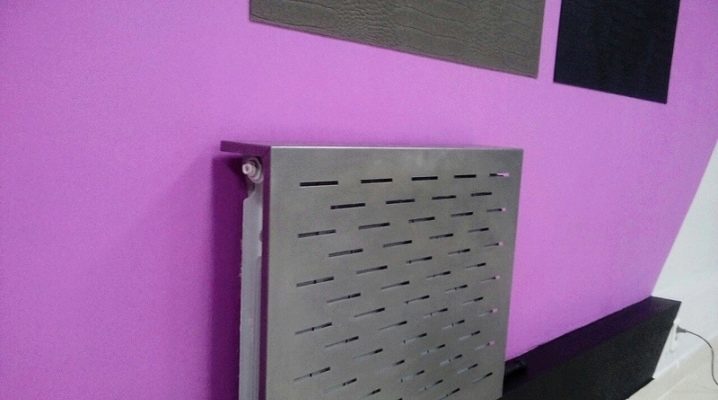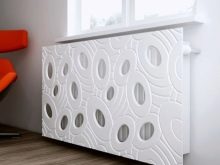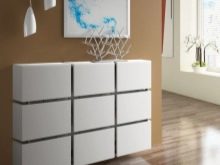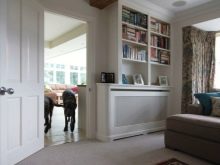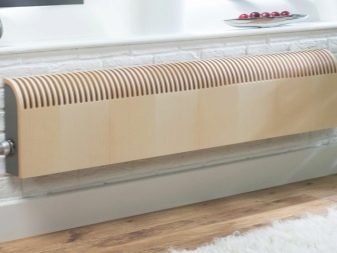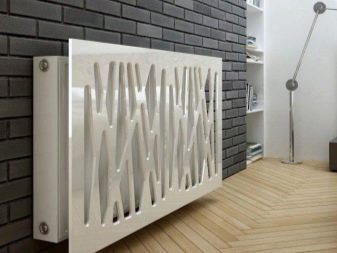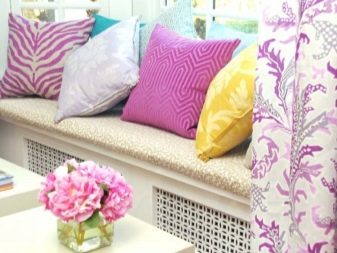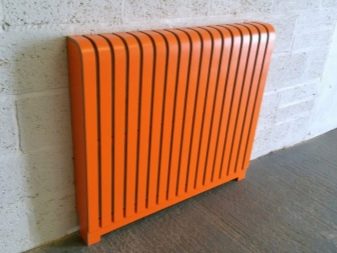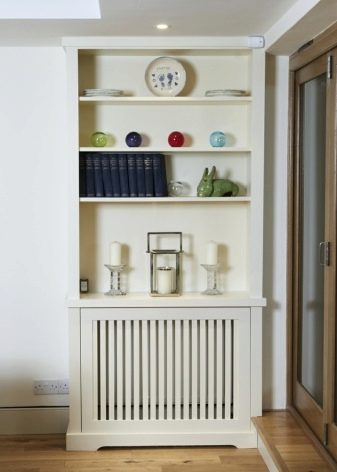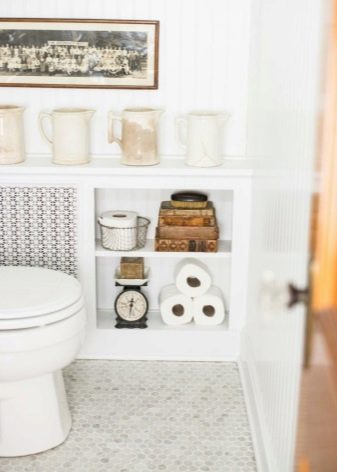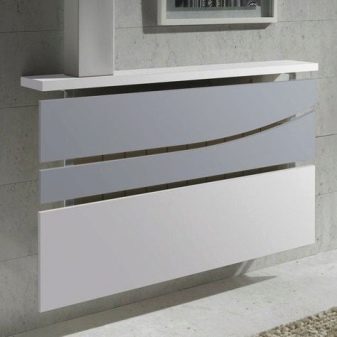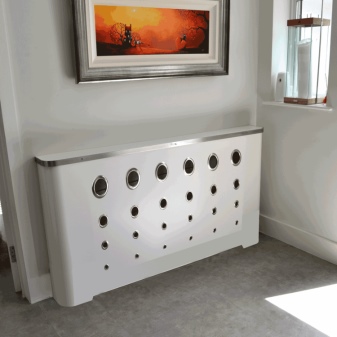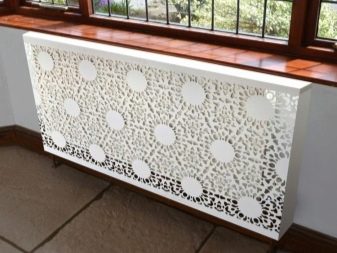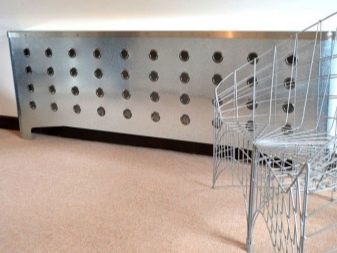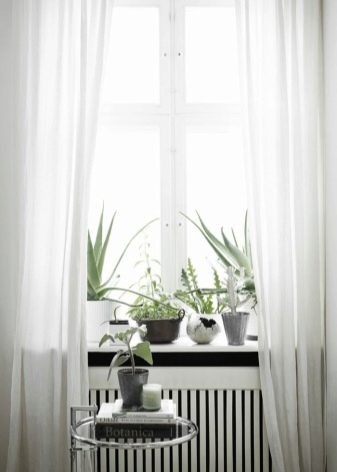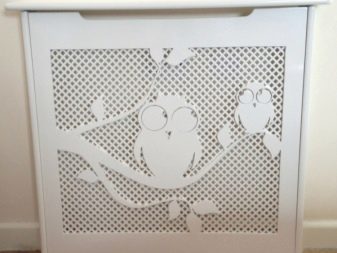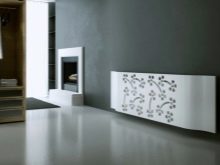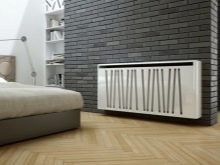Features and types of metal screens on the battery of heating
Current safety requirements do not allow open access to heating appliances. They must be partially or completely blocked. In this regard, various types of screens for heating systems have been developed, which protect against unexpected contact with a hot surface and act as a kind of decorative element. When repairing a room, there is often a problem when the elements of the heating system do not match the interior or spoil it with their shabby appearance.
Using the screen, you can block the overview of the appearance of the battery, its side or top. Developed ready-made designs from several screens, allowing to apply them as an independent object.The undoubted advantage of any screen on the heating battery is that it protects the system from dust penetration and its subsidence on surfaces that are difficult to reach when washing.
Materials
Protective screens on the heating battery is made of various materials. Currently most commonly used:
- wood;
- plastic;
- silicate glass;
- metal;
- medium fiber plates.
Plastic and wood attract buyers with a wide assortment and the possibility of translating the ideas of a design project. And the price of such panels is much lower than that of metal models. Metallic are distinguished by greater strength and practicality, good heat exchange.
Each grille for a heating radiator must have certain characteristics, such as environmental friendliness and safety, no deformation during heating; excellent heat dissipation, color fastness, simplicity, durability and ease of installation and maintenance.
Types of screens
Interior grilles for radiators differ not only in the materials from which they are made, but also in the type of construction. Many screens are made of stainless steel or painted sheet steel.
By type of construction are:
- built-in;
- mounted.
Embedded Screens
This type of panels for radiators are made of steel sheet with perforations. Screens for decoration can be installed in openings or wall niches.
Starting installation of the grille, it is necessary to strictly follow the contents of the instructions, apply silicone sealants and screws. It is best to entrust this work to professionals.
Metal grilles may be convex. This is necessary in order to hide the heating pipes, partially protruding forward. This screen can be of two types: mortise or invoice. In the choice of guided by the interior of the apartment.
Mounted screens
They do not require special skills in installation and professionalism, as they are mounted very easily. This type of screen is simply hung on the radiator. Anyone can handle it. Hinged grilles do not interfere with heat transfer and ventilation, therefore, the most common.
Such screens are made of metal sheets with holes all over the plane. Good heat dissipation of the metal and the presence of frequent holes in the wall of the screen help the room to quickly and evenly heat up. The shape of the hinged panel can be rectangular or rounded around the edge, with one or two lateral sides, or not at all.But also metal screens can be made for pipes, which are supplied from one or from two sides to the radiator.
The hinged panels are quickly dismantled during maintenance or repair work in the heating system.
They are perfect for cast iron radiator, as long as the manufacturer is reliable.
Painted sheet steel screens
Staining is a powder polymer dye. This type of painting gives a neat look and durability of the coating. But there is a lack of such painted panels. The range of types of design and colors is very poor. And besides, mounted protective screens are suitable only for those radiators for which they were made. The durability of the panel for the radiator depends on the quality of their painting. The most sustainable method is powder spraying.
For exclusive interiors, it is possible to create screens using artistic forging. But such screens are very expensive. The best option in the forged screen is its production from a perforated sheet.Most often forged metal screens serve only as an element of decor in the interior.
Stainless Steel Panels
In its pure form, this steel has good external qualities. A variety of material processing options allow you to perform any screen design project in any of the known styles. The disadvantages of stainless steel screens are that their cost is very high, and there is a difficulty in choosing its design.
But when choosing a metal screen, it is necessary to pay attention not only to external signs. They must be designed so that there is no interference in the operation of the heating system, and the air permeability is at a fixed level.
Metal panels have a simple construction, but must meet certain criteria. This makes it easy to mount them on the radiator and use them for a long time without any changes.
Screen Specifications:
- standard size - corresponds to the dimensions of the heating battery;
- strength - maintains shape and position even after applying a mechanical load;
- heat resistance - characteristics should not change when exposed to high temperatures;
- radiator grill capacity - if there is a screen, the air circulation should remainat the same level.
Grille, made of metal, are available in different variations:
- composed of a variety of structural elements;
- with additional parts available;
- with partial or continuous overlap on all sides;
- with decorative design of the front of the screen.
Differences in panel design
Panel grille can be made in several ways. The most commonly used are: a sheet of metal in which holes are made, or a metal mesh attached to the base of the screen. The mesh can be woven from metal thin rods with cells of different sizes. The size and number of these holes, cells depends on the quality of the passage of air flow and, accordingly, the rate of space heating. The mounting position of the screen on the radiator is also varied:
- the panel can be installed directly on the battery (hang up);
- can touch the battery and fasten with brackets to the wall;
- be removed from the surface of the radiator on the brackets;
- may have its own fastening and be a partial element of the panel system.
The most convenient option is considered when access to the heating system remains free in case of need or unforeseen situations. Those versions of the screens that are mounted to the wall, do not have this quality, but are also in demand.
By the presence of the upper and lateral sides of the screen, which have inserts in the form of a grid, 2 groups of samples are also distinguished.
- First group it is made in a removable version, and also it can be a single whole with a sheet of panel.
- The second is performed with regard to pipes that are supplied to the heating system, and has ready cuts for them. It is possible that when the places for the holes are prepared, they need only be pushed through.
Certain models of lattices have the function of connecting several parts into a general structure with the help of special fixings. In this case, you can install the screen to the desired length to overlap the entire system along with the supplied pipes.
Screens for radiators have become the most versatile subject that helps to avoid many unwanted traumatic situations. In addition, it is a great way to decorate sections of unsightly looking walls and just become an element of the interior.In a modern apartment, these structures are widely used due to their simplicity and affordability. When choosing a metal screen in your home, for the best transfer of warm air, give preference to models that do not have a top cover and have free access to air below.
Pay attention to the size of the holes: too small will not cope with the heat transfer, convection flow will go poorly. They will not keep the heat exchange in your home at the same level. And the cost of heating will increase significantly.
For information on how to install a metal screen on a radiator, see the following video.
